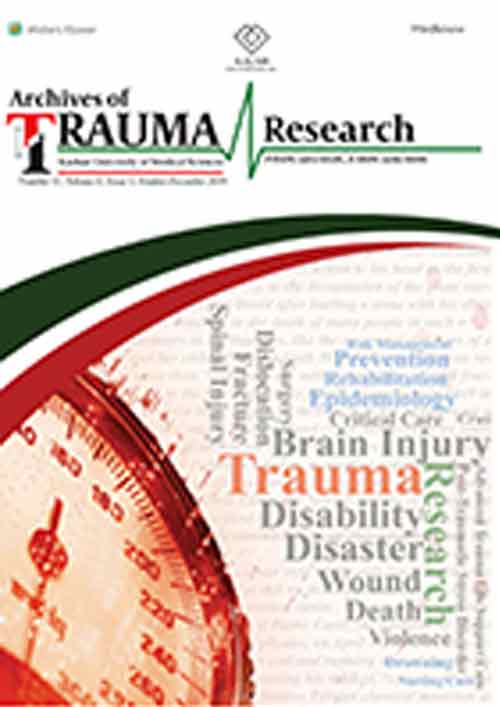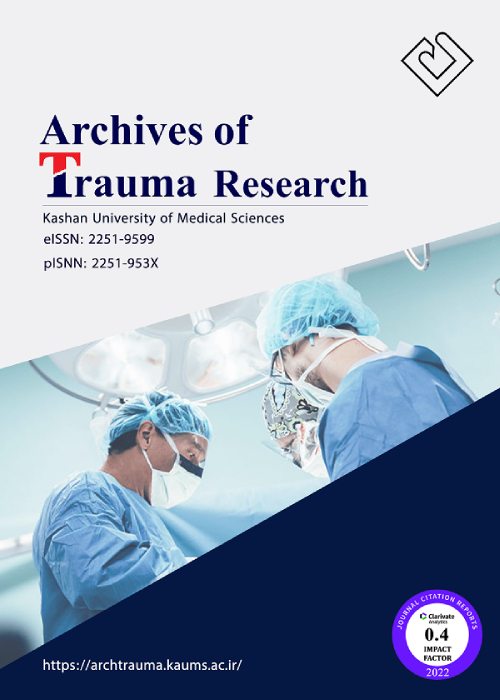فهرست مطالب

Archives of Trauma Research
Volume:8 Issue: 4, Oct-Dec 2019
- تاریخ انتشار: 1398/09/29
- تعداد عناوین: 8
-
-
Pages 185-189
Surgical treatment of displaced articular fractures of the calcaneus is currently recommended by most authors. Different surgical procedures are described in literature. The purpose of this study is to evaluate the functional and anatomic results of articular fractures of the calcaneus surgically treated with the modified Palmer method and precise the place, the conditions, and the advantages of this technique for articular fractures of the calcaneus. This is a retrospective study assessing the outcomes of surgical treatment of articular calcaneal fractures surgically treated using the modified Palmer technique. Twenty-two patients underwent this surgery for 6 years. All patients have diabetes and/or smoking history, and physical examination revealed a severe swelling within the hindfoot. Sanders classification Type II was found in 6 cases, whereas 18 cases fell below Type III. The mean preoperative Bohler angle was about −2.7°. An extended lateral approach was performed, and the void caused by elevating the intra-articular surface was filled by an iliac crest graft firmly impacted in all cases. Additional limited fixation was performed in 71% of patients. On follow-up, the functional and anatomic results were analyzed, respectively, by Kitaoka and Babin’s quotations, and the radiological assessment was based on Bohler angle. No cutaneous or infectious complications were observed after surgery. The mean postoperative Bohler angle was 21.9°, and it was 19.8° at the last follow-up with a significant difference. At follow-up, the mean functional Kitaoka score was 75; it was considered as excellent in four cases, good in ten, fair in eight, and poor in two patients. The modified Palmer technique is a simple surgical procedure to treat intra-articular calcaneal fractures. It provides encouraging results. This method is recommended in the case of Sander’s II and III calcaneal fracture for patients with a high risk of cutaneous complications to avoid infection and cutaneous complications.
Keywords: Bone autograft, calcaneus, fixation, intra-articular fracture, Palmer technique -
Pages 190-197Background
Injuries caused by home injuries in children under 5 years of age is one of the main causes of death in this group and also constitutes a significant public health burden. This review aimed at summarizing the literature on the effectiveness of interventions to prevent home injuries in children under 5 years of age.
MethodsMagiran, Iran Medex, and SID in Persian Scientific databases and BioMed Central, PubMed, ScienceDirect, Web of Science, and Scopus were systematically searched for articles published up to June 2016. Then, two researchers reviewed the papers independently and finally, 14 studies fulfilled the inclusion criteria.
ResultsThe results showed the effectiveness of intervention measures including training sessions at home, home visit, group discussions, and interviews as the educational tools. The educational approach was used as the intervention in 11 studies; legislative/incentive approach and engineering/technology approaches had not been used in papers; and three studies had used the educational intervention and engineering/technological approaches.
ConclusionsMost of the effective inventions included studies that used the combination of effective methods to reduce the risk of injuries. Since the accidents are preventable, the appropriate intervention strategies, especially active intervention or a combination of interventional measures are effective to reduce the risk of home accidents and injuries in children.
Keywords: Children, home accidents, injury, systematic review -
Pages 198-202Introduction
Skeletal traction provides pain relief and temporary stability in patients anticipating surgery for a variety of lower-extremity fractures. Recent literature suggests that distal femoral traction provides pain relief and is safe; however, data regarding proximal tibial and calcaneal pins are primarily historical and limited. The purpose of this study is to document complications associated with distal femur, proximal tibia, and calcaneal traction pin placement.
Materials and MethodsWe identified patients with the distal femur, proximal tibia, and calcaneal traction pin placement from January 2013 to June 2016. Chart review was utilized to identify any complications, including nerve or vascular injuries, need for revision, or infection.
ResultsFive hundred and nineteen traction pins were eligible for review, consisting of 120 calcaneal traction pins, 129 distal femoral pins, and 270 proximal tibia traction pins. Primary diagnosis was defined as 305 femur fractures (58.8%), 60 tibial shaft fractures (11.6%), 60 acetabular fractures (11.6%), 38 pilon fractures (7.3%), 30 pelvic ring injuries (5.8%), 21 tibial plateau fractures (4.0%), and 5 hip dislocations (1.0%). We identified 17 (3.3%) adverse events potentially attributable to traction pin insertion. Pins that became infected were found to have been in place for a significantly longer duration (18.3 days compared to 5.8 days, P = 0.0001).
ConclusionsTraction pin placement for skeletal traction is generally an uncomplicated procedure. Duration of pin placement is significantly related to the likelihood of pin site infection.
Keywords: Complications, fracture care, infection, skeletal traction -
Pages 203-206Background
Organ failure (OF) and sepsis are important causes of late death in trauma. Previous studies reported the methods that could predict OF at the time of patient arrival. However, most of the evidence is from high-income countries, where health-care systems were different from developing countries. This research aimed to identify the factors to predict late complications in trauma patients in surgical intensive care units (SICUs).
MethodsThis study was a secondary data analysis from the THAI-SICU study, which was a prospective cohort study in nine university-based-SICUs in Thailand. Late complications were defined as any OF or sepsis that occurred after 48 h of ICU admission. Multivariable logistic regression was conducted to identify the significant factors.
ResultsThree hundred and fourteen patients were eligible for the analysis. Late complications occurred in 60 patients (19%). Patients who had complications had higher Acute Physiology and Chronic Health Enquiry (APACHE II) (15.8 vs. 12.4, P = 0.02) and Sequential OF Assessment (SOFA) scores on admission (6.7 vs. 3.8, P < 0.001). Multivariable analysis showed that current smoking (odds ratio [OR] =1.9, 95% confidence interval [CI]; 1.03–3.67, P = 0.04) and SOFA score on admission (OR = 1.2, 95% CI; 1.12–1.29, P < 0.001) increased the risk of late complications. Late complications had hazards ratio of mortality of 5.9 (95% CI; 2.53–13.88, P < 0.001).
ConclusionsThe incidence of late complications in trauma patients in the SICU was 19%. Current smoking and SOFA score might be valuable in future prediction of late complications during admission.
Keywords: Critical care, multiple organ failure, sepsis -
Pages 207-213
Extended-focused assessment with sonography in trauma (E-FAST) has been introduced as a free fluid identification technique in the abdomen, and currently, like stethoscopes, it is routinely used to assess traumatic patients, as part of physical examination tools. We decided to examine the effect of using E-FAST in the clinical judgment of the physicians managing patients with blunt abdominal and chest wall trauma.
Materials and MethodsIn this cross-sectional study, all patients who were admitted from May 2014 till May 2015 to the emergency department of Imam Khomeini and Sina Hospitals, Tehran, Iran, with an abdominal or chest blunt trauma and for whom E-FAST was conducted were enrolled. In a preprepared checklist, possible consequences based on the primary clinical judgment of a physician were recorded; and then, the results from E-FAST on existence or nonexistence of free fluid or air in the peritoneal or pleural space were presented, and the possible consequences according to the results obtained from the E-FAST were also recorded again. Based on actual outcome of patients’ condition in the first 24 h, statistical characteristics for each pathology were calculated.
ResultsIn this study, 115 patients with a mean age of 36.20 ± 12.37 years were examined including 92 (80%) men. The correlation coefficient between the possibility of hemorrhagic shock, pneumothorax, hemoperitoneum, solid organ damage, and hemothorax before and after the E-FAST based on the Kappa criteria was 0.803, 0.642, 0.430, 0.331, and 0.318, respectively.
ConclusionThe results of this study showed that performing E-FAST increases the sensitivity of history and physical examination in diagnosis of pneumothorax, hemoperitoneum, solid organ damage, and hemothorax.
Keywords: Clinical decision-making, emergency department, extended-focused assessment with sonography in trauma examination, multiple trauma -
Pages 214-218Introduction
Head trauma is one of the most important causes of death in trauma centers. In particular, treatment of head injury in the elderly seems more complicated than that of the young and middle aged. This study aimed to identify the outcomes of head trauma due to road traffic accidents (RTAs) in elderly patients.
Materials and MethodsIn a descriptive-analytical study, records of 294 elderly patients with head trauma due to RTA retrieved from health information system were reviewed using a checklist. The outcomes of patients were evaluated using the Glasgow Outcome Scale. Complete recovery and partial disability were considered as favorable outcomes, whereas severe disability, vegetative state, and death were defined as unfavorable outcomes. Descriptive factors and adjusted coefficients were calculated using SPSS software.
ResultsOf 294 elderly patients, 77.2% were men. About half of the road accidents had occurred in urban areas (58.8%). Less than half of the injured elderly were pedestrian (44.9%). The mean Glasgow Coma Scale of patients equaled 13.42 ± 3.29. Unfavorable outcomes were observed only in 20.4% of the patients. There were significant differences in head injury severity between the groups with favorable and unfavorable outcomes (P < 0.05). Moreover, intraventricular hemorrhage was significantly associated with the highest prevalence of unfavorable outcome followed by intracranial hemorrhage.
ConclusionThe results of our study mentioned that most of the elderly who had accidents were pedestrian, most of which occurred in the cities. Moderate and severe head injuries in patients had unfavorable clinical outcome.
Keywords: Elderly, head trauma, road traffic accident -
Pages 219-228Objectives
Road traffic accidents are much higher than the global average in Iran. Since the main cause of road traffic accidents is attributed to driver’s risky behaviors, the aim of this study was to investigate the knowledge, attitude, and violation of drivers toward traffic regulations in Bandar Abbas, Iran.
MethodsThe study was carried out among 562 drivers in Bandar Abbas using cluster sampling method. The data were collected through a valid and reliable researcher-made questionnaire that had four sections including items assessing the demographic, knowledge, attitude, and violation of drivers toward traffic regulations.
ResultsThe mean score for drivers’ knowledge, attitude, and violations were estimated to be 8.71 ± 2.5, 42.4 ± 7.6, and 56.7 ± 11.8, respectively. Drivers’ knowledge and attitude levels were low; only 11.4% of men and 9% of women had good knowledge. The use of mobile phone (74.6%) and drunk driving (9.4%) were reported as the most frequent and the least frequent driving behaviors, respectively. There was a significant relationship between knowledge with attitude, knowledge with violations, and attitude with violations (P < 0.001). Marital status, age, and driving history were significantly associated with drivers’ knowledge, attitude, and violations (P < 0.001).
ConclusionsIt is recommended to reduce driving violations by implementing targeted and comprehensive plans to raising the level of knowledge and attitude of drivers toward driving regulations.
Keywords: Attitude, driving violations, knowledge, traffic regulations


